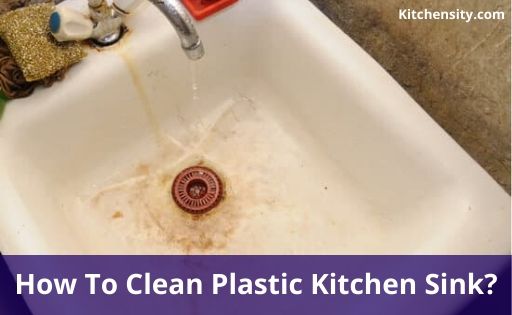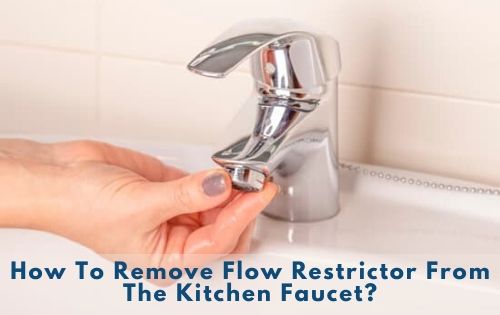Plastic kitchen sinks are mostly white in color and made of acrylic, so, it attracts stains. But don’t worry, we will learn how to clean plastic kitchen sink easily.
Everybody knows how much sinks are important in the kitchen. From washing hands to vegetables, we need it for everything.
That’s why there is a big possibility of getting it dirty and mostly if the sink is light in color.
In the case of plastic sinks, if anybody puts any hot pan or pot in the sink then the area may get dark in color. Because the hot pan can melt the plastic and put a dark spot on it.
So, always be careful if you have a plastic sink in the kitchen. Don’t put any hot items directly on it.
Now let’s clean it.

Table of Contents
- 1 How To Clean Plastic Kitchen Sink?
- 2 Safety Precautions
- 3 Clean Plastic Kitchen Sink For Lighter Stains
- 4 Clean Plastic Kitchen Sink For Darker Stains
- 5 Alternative Cleaners
- 6 Different Types Of Plastic Sink Finishes
- 7 How To Remove Hard Water Stains From Plastic?
- 8 Can You Paint A Plastic Kitchen Sink?
- 9 Important Maintenance Tips
- 10 Troubleshooting Common Issues
- 11 Conclusion
- 12 FAQ’s
How To Clean Plastic Kitchen Sink?
To clean a plastic kitchen sink, start by sprinkling baking soda on the stains. Then, spray vinegar and scrub with a brush. Rinse with water and apply dish soap. Let it sit, then polish it with a microfiber cloth for a clean and sparkling sink.
For darker stains or spots due to hot items, suitable methods are discussed below.
Also Read – Best Basin Wrench Alternatives
Safety Precautions
Before you begin cleaning your plastic kitchen sink, it’s important to prioritize safety.
Taking the necessary precautions will ensure that you protect yourself and create a safe environment. Here are some safety measures to keep in mind:
Wear Protective Gear
- Whenever you are working with cleaning agents or chemicals, it is advisable to wear protective gloves.
- This will shield your hands from any potential skin irritation or contact with harsh substances.
- Additionally, wearing a mask can prevent you from inhaling any fumes or particles that may be released during the cleaning process.
Also Read – How To Remove Kitchen Faucet Without Basin Wrench?
Work In A Well-Ventilated Area
- Adequate ventilation is crucial when using cleaning chemicals or agents.
- Open windows and doors to allow fresh air to circulate and help dissipate any fumes.
- If possible, turn on exhaust fans or use portable fans to further improve air circulation.
- Working in a well-ventilated area minimizes exposure to potentially harmful substances.
Read And Follow The Instructions
- Different cleaning agents may have specific usage instructions and safety recommendations provided by the manufacturer.
- It’s essential to carefully read and follow these instructions to ensure safe and effective use.
- Pay attention to any warnings or precautions mentioned on the product labels.
Also Read – Low Water Pressure In The Kitchen Sink: How To Fix It?
Keep Children And Pets Away
- While cleaning your plastic kitchen sink, it’s important to keep children and pets at a safe distance.
- Cleaning agents, tools, and potentially slippery surfaces can pose hazards.
- Prevent accidents by restricting access to the cleaning area until you have completed the task and the sink is thoroughly rinsed and dry.
Store Cleaning Products Properly
- After you have finished cleaning, make sure to store all cleaning products in a secure location that is out of reach of children and pets.
- Follow the recommended storage guidelines provided by the manufacturer to prevent accidental ingestion or misuse.
By emphasizing these safety precautions, you ensure that readers approach the cleaning process with caution and prioritize their well-being.
Safety should always be a top priority when working with cleaning agents or chemicals.
Also Read – How To Fix A Faucet Handle That Turns Too Far?
Clean Plastic Kitchen Sink For Lighter Stains
For lighter stains, I have already discussed the method above but for clarity, I will write here step by step.
What Do You Need?
- Baking Soda
- Vinegar
- Dish Soap Liquid
- Microfiber Brush or Any Soft Brush
You will need only these items. Now, try these steps to clean it.
Step 1: Sprinkle some baking soda on the affected portion or to the whole sink.
Step 2: Spray some vinegar on the portion where you have applied the baking soda.
Step 3: After that, wait for a few minutes and then rub with a soft brush.
Step 4: Rinse the water and clean the area nicely.
Step 5: Now, plug the drain and squirt some liquid dish soap and run the hot water tap till it gets half-filled.
Step 6: Let the water sit for 30-45 mins and then drain it.
Step 7: Finally, polish the plastic sink with a microfiber brush and rinse with water to get a nice, clean, and glazing sink.
You can replace the baking soda and vinegar with a chemical cleaner to get similar results. For cleaners, you can click here to check on Amazon. That’s it!
You May Also Like: How To Unclog A Sink Clogged With Coffee Grounds?
Clean Plastic Kitchen Sink For Darker Stains
If the stain is darker or the spot is due to hot items then you have to work a little harder to get it done. But don’t worry about it we will sort it out, how to clean it.
Whatever stains you may have, always try the first method that I have discussed above.
If it does not work then try this method because in this method we sometimes use a stiff brush depending on the stain to clean it which may result in scratches.
You May Also Like: 6 Pull Out Spray Kitchen Faucet Problems
What Do You Need?
- Oven Cleaner
- Any sink cleaner
- Steel Wool or Hard Stiff Brush (For severe stains)
- Lemon
- Dish Soap Liquid
That’s it, you will need these items only if you have stubborn stains left after the first method.
Step 1: First wear masks and gloves so that the harsh chemicals won’t harm you.
Step 2: Apply the oven cleaner to the affected portion and rub it with a brush or scrubber.
Step 3: Squirts the sink cleaner to the same part and let the mixture sit for 20-30 mins.
Step 4: After that, rub with a brush or steel wool and rinse with water and clean it.
Step 5: Now, take the lemon, squeeze it and rub the whole sink and clean it with water. This will help to disinfect the sink.
Step 6: Plug the drain, squirt the dish soap liquid, and run the hot water tap until it gets half-filled and let it sit for 30-45 mins.
Step 7: Finally, drain the sink and polish it with a microfiber brush and rinse with water to get a nice, clean, and glazing sink.
Note: If the sink is still not get cleaned, then you can repeat Steps 2 to Step 4, and this time you can use a little hard brush to clean it. You can get little scratches but this will not harm the sink.
If you follow these steps then you will definitely get the result. Because these all are proven steps that have worked for me and for others also.
Also Read – How To Lubricate A Swivel Faucet?
Alternative Cleaners
While chemical cleaners can be effective in cleaning plastic kitchen sinks, some individuals prefer using natural and eco-friendly alternatives.
These alternatives offer a greener approach to cleaning while still providing satisfactory results.
Here’s one such alternative using lemon juice and baking soda:
Lemon juice and baking soda create a powerful natural cleaning combination that can effectively tackle stains, remove odors, and leave your plastic sink looking fresh.
Here’s how to use this eco-friendly alternative:
- Cut a fresh lemon in half and squeeze the juice into a bowl. Alternatively, you can use bottled lemon juice if fresh lemons are not available.
- Sprinkle a generous amount of baking soda over the stained or dirty areas of the sink. Baking soda acts as a gentle abrasive that helps remove stains and grime.
- Dip a clean cloth or a soft brush into the lemon juice and apply it to the baking soda-covered areas. The acid in the lemon juice reacts with the baking soda, creating a mild foaming action that helps lift and loosen dirt and stains.
- Gently scrub the sink using the lemon juice-soaked cloth or brush. Focus on the areas with stains or discoloration, applying a bit more pressure if needed. The combination of lemon juice and baking soda will work together to break down stains and leave the sink looking cleaner.
- Rinse the sink thoroughly with warm water to remove any residue. Use a clean cloth or sponge to wipe away the baking soda and lemon juice mixture.
This natural cleaning method is not only effective but also environmentally friendly.
Lemon juice contains citric acid, which has antimicrobial properties, making it a great natural disinfectant.
Baking soda helps eliminate odors, leaving your sink smelling fresh and clean.
Also Read – How To Fix A Stiff Kitchen Faucet?
Different Types Of Plastic Sink Finishes
Plastic kitchen sinks are available in different finishes, such as glossy or matte, which can require specific cleaning considerations to maintain their appearance. Let’s explore the cleaning requirements for each type of finish:
Glossy Finish
Plastic sinks with a glossy finish have a smooth and reflective surface.
To keep this finish looking pristine, it’s important to use gentle cleaning methods and non-abrasive products.
Here are some tips for cleaning a glossy plastic sink:
- Avoid abrasive cleaners or scrub brushes that can scratch the surface. Instead, opt for soft cloths, microfiber brushes, or non-abrasive sponges.
- Use mild dish soap or a gentle all-purpose cleaner to clean the sink. Dilute the cleaner with water according to the manufacturer’s instructions.
- Rinse the sink thoroughly after cleaning to remove any soap residue or cleaner.
- Dry the sink with a soft cloth to prevent water spots or mineral deposits from forming on the glossy surface.
- If there are stubborn stains or discoloration, you can try using a baking soda paste (baking soda mixed with water) as a mild abrasive. Apply the paste, gently scrub with a soft cloth, and rinse thoroughly.
Also Read – How To Fix A Spinning Faucet Handle?
Matte Finish
Plastic sinks with a matte finish have a more textured and non-reflective surface.
While these sinks are less prone to showing scratches and water spots, they can still accumulate dirt and stains.
Here are some cleaning tips specific to matte plastic sinks:
- Use a mild dish soap or a non-abrasive, non-acidic cleaner specifically formulated for matte surfaces. Avoid harsh chemicals or abrasive cleaners that can damage the finish.
- Use a soft brush, microfiber cloth, or non-abrasive sponge to clean the sink. Gently scrub in a circular motion to remove dirt and stains.
- Rinse the sink thoroughly after cleaning to remove any residue.
- Dry the sink with a soft cloth to prevent water spots or mineral deposits from forming on the surface.
- For stubborn stains, you can try using a mixture of baking soda and water. Create a paste, apply it to the stain, and let it sit for a few minutes before gently scrubbing and rinsing.
It’s important to note that regardless of the finish, it’s always best to follow the manufacturer’s recommendations for cleaning and maintenance.
Some plastic sinks may have specific care instructions or recommend certain cleaning products to preserve the finish and avoid damage.
Also Read – How To Remove Handle From Faucet?
How To Remove Hard Water Stains From Plastic?
Hard water stains can be stubborn and challenging to remove, but with the right approach, you can effectively eliminate them from your plastic surfaces.
Here’s a step-by-step guide on how to remove hard water stains from plastic:
Gather Your Supplies
- White vinegar
- Lemon juice
- Baking soda
- Soft cloth or sponge
- Water
Create A Vinegar Solution
- Mix equal parts of white vinegar and water in a bowl or spray bottle.
- The acidic properties of vinegar help dissolve mineral deposits and break down hard water stains.
Apply The Vinegar Solution
- Dampen a soft cloth or sponge with the vinegar solution.
- Gently scrub the hard water stains on the plastic surface.
- Let the solution sit on the stains for a few minutes to allow the vinegar to penetrate.
Scrub With Baking Soda
- For more stubborn stains, create a paste by mixing baking soda with a small amount of water.
- Apply the baking soda paste directly to the stains and gently scrub using a soft cloth or sponge.
- Baking soda acts as a mild abrasive that helps lift and remove the mineral deposits.
Rinse With Water
- Once you have scrubbed the stains with vinegar and baking soda, rinse the plastic surface thoroughly with clean water.
- Make sure to remove all traces of the cleaning agents.
Lemon Juice Treatment
- If any hard water stains remain, you can try using lemon juice as a natural alternative.
- Squeeze fresh lemon juice directly onto the remaining stains and let it sit for a few minutes.
- Lemon juice contains citric acid, which helps break down mineral deposits.
- Scrub the stains gently with a soft cloth or sponge, then rinse with water.
Repeat If Necessary
- For severe hard water stains, you may need to repeat the process multiple times.
- Persistence and thoroughness are key to achieving the best results.
Prevent Future Stains
- To prevent future hard water stains, consider using a water softener or installing a water filtration system in your home.
- Regularly wiping down the plastic surfaces with a soft cloth or sponge after each use can also help prevent mineral buildup.
It’s important to note that different types of plastic may react differently to cleaning methods.
Always test any cleaning solution on a small, inconspicuous area first to ensure it doesn’t cause any damage or discoloration.
By following these steps and being diligent in your cleaning efforts, you can successfully remove hard water stains from plastic surfaces and restore their cleanliness and appearance.
Also Read – How To Remove Flow Restrictor From The Kitchen Faucet?
Can You Paint A Plastic Kitchen Sink?
Yes, it is possible to paint a plastic kitchen sink. Painting a plastic sink can be a cost-effective way to update its appearance and give it a fresh look.
However, it’s important to note that painting a sink is a temporary solution and the paint may wear off over time, especially in high-use areas.
Here’s a general guide on how to paint a plastic kitchen sink:
Prepare The Sink
- Thoroughly clean the sink using mild detergent and warm water.
- Rinse it well to remove any soap residue.
- Make sure the sink is completely dry before proceeding.
Sand The Surface
- Lightly sand the surface of the sink with a fine-grit sandpaper.
- This step helps to create a rough surface that allows the paint to adhere better.
- Wipe away any dust or debris resulting from sanding.
Apply Primer
- Use a high-quality plastic primer specifically designed for painting plastic surfaces.
- Apply the primer evenly to the sink using a brush or a roller, following the manufacturer’s instructions.
- Allow the primer to dry completely before proceeding.
Choose The Right Paint
- Select a paint that is suitable for plastic surfaces and is labeled as durable, waterproof, and suitable for high-moisture areas.
- Acrylic enamel or epoxy-based paints are often recommended for painting plastic sinks.
Apply The Paint
- Using a brush or a roller, apply thin and even coats of paint to the sink.
- Start from the edges and work your way toward the center.
- Allow each coat to dry completely before applying the next one.
- Apply multiple coats as needed to achieve the desired coverage.
Seal The Paint (Optional)
- To provide added protection and durability to the painted surface, you may choose to apply a clear, waterproof sealant.
- This step is optional but can help extend the life of the paint job.
Allow Sufficient Curing Time
- After the final coat of paint and sealant (if used), allow the sink to cure and dry completely according to the manufacturer’s instructions.
- This curing time ensures that the paint fully sets and hardens before using the sink.
Maintain And Clean The Painted Sink
- Avoid using abrasive cleaners or scrubbers that may scratch the painted surface.
- Instead, use mild soap and water for regular cleaning.
- Be mindful that excessive scrubbing or exposure to harsh chemicals can potentially damage the painted finish.
It’s important to note that painting a plastic sink may not be as durable or long-lasting as other options like replacing the sink or using specialized refinishing kits.
Additionally, painted surfaces may be prone to chipping, peeling, or fading over time, especially in areas that experience heavy use.
Consider your specific needs and expectations before deciding to paint a plastic kitchen sink.
If you’re unsure about the process or want a more permanent solution, it’s advisable to consult a professional or explore alternative options for updating your sink’s appearance.
Also Read – How To Fix A Leaky Kitchen Faucet?
Important Maintenance Tips
Regular maintenance is crucial to keep your plastic kitchen sink in good condition and extend its lifespan.
By following these maintenance tips, you can ensure that your sink stays clean, free from scratches, and maintains its appearance over time:
Avoid Abrasive Scrubbers And Cleaners
- To prevent scratching or damaging the surface of your plastic sink, avoid using abrasive scrub brushes, steel wool, or harsh cleaners.
- These can leave visible marks and compromise the sink’s finish. Instead, opt for soft cloths, microfiber brushes, or non-abrasive sponges when cleaning your sink.
- Additionally, choose gentle cleaners specifically formulated for plastic sinks or mild dish soap diluted with water.
Wipe The Sink Dry After Each Use
- To minimize the risk of water spots, mineral buildup, and staining, it’s important to wipe your plastic sink dry after each use.
- Use a soft cloth or paper towel to remove any standing water or moisture from the sink’s surface.
- This practice helps prevent water spots and mineral deposits from forming, which can be particularly noticeable on glossy finishes.
Clean Spills And Stains Promptly
- To maintain the cleanliness and appearance of your plastic sink, address spills and stains as soon as possible.
- Liquids such as coffee, tea, or fruit juices can potentially leave stains if left untreated.
- Wipe up any spills promptly using a soft cloth or sponge, and clean the affected area with mild dish soap or a suitable plastic cleaner.
- Regularly attending to spills will help prevent long-term staining and make your cleaning routine easier.
Also Read – Tighten A Loose Moen Single Handle Kitchen Faucet & Base
Avoid Placing Hot Items Directly In The Sink
- While plastic sinks are durable, they can be susceptible to damage from extreme heat.
- To prevent potential discoloration or warping, avoid placing hot pots, pans, or other heated items directly into the sink.
- Use trivets or heat-resistant mats to protect the sink’s surface.
- This practice will help maintain the sink’s appearance and prevent any heat-related damage.
Periodic Deep Cleaning
- In addition to regular maintenance, consider giving your plastic sink a periodic deep cleaning.
- This can involve using the baking soda and vinegar method or any other suitable cleaner for your sink’s finish.
- A deep cleaning helps remove stubborn stains, eliminate odors, and restore the sink’s overall cleanliness and shine.
By following these maintenance tips, you can ensure that your plastic kitchen sink remains in excellent condition, free from scratches, stains, and mineral buildup.
Incorporating these practices into your routine will help prolong the lifespan of your sink and keep it looking its best.
Also Read – How To Remove Flow Restrictor From The Kitchen Faucet?
Troubleshooting Common Issues
While regular cleaning and maintenance can keep your plastic kitchen sink in good condition, you may encounter some common issues along the way.
Here are some troubleshooting tips to help you tackle persistent stains, scratches, and other problems effectively:
Persistent Stains
If you’re dealing with stubborn stains that are not easily removed with regular cleaning methods, try the following techniques:
- Make a paste using baking soda and water.
- Apply the paste to the stained area, let it sit for a few minutes, and then gently scrub with a soft brush or sponge.
- Rinse thoroughly with water.
- Alternatively, you can use a commercial stain remover specifically formulated for plastic sinks.
- Follow the instructions on the product carefully and test it on a small, inconspicuous area of the sink before applying it to the stain.
Scratches
While plastic sinks are generally more resistant to scratches compared to other materials, they can still develop surface marks over time.
Here’s how you can minimize the visibility of scratches:
- For minor scratches, apply a small amount of toothpaste or baking soda mixed with water to the affected area.
- Gently rub the scratch in a circular motion using a soft cloth or sponge.
- Rinse thoroughly and assess the results. Repeat if necessary.
- If the scratches are deeper or more prominent, you can try using a plastic repair kit designed for repairing scratches in sinks.
- Follow the instructions provided with the kit carefully to achieve the best results.
Discoloration Or Fading
If your plastic sink is experiencing discoloration or fading, there are a few steps you can take to address the issue:
- Apply a non-abrasive plastic restorer or polish to the sink’s surface.
- Follow the manufacturer’s instructions on how to apply and buff the product to restore color and shine.
- If the discoloration or fading is extensive and cannot be resolved through restoration, you may need to consider replacing the sink.
- Consult a professional or contact the sink manufacturer for further guidance.
Odors
If your plastic sink is emitting unpleasant odors, there are a couple of methods you can try to eliminate them:
- Create a mixture of equal parts white vinegar and water.
- Pour the solution into the sink and let it sit for about 15-20 minutes.
- Rinse thoroughly with water to remove any vinegar residue.
- Sprinkle baking soda over the sink’s surface and let it sit for a few hours or overnight.
- Rinse the sink thoroughly with water to remove the baking soda and any lingering odors.
By addressing these common troubleshooting issues, you can effectively tackle persistent stains, scratches, discoloration, and odors that may arise with your plastic kitchen sink.
However, it’s important to consider the specific instructions and recommendations from the sink manufacturer, as different sinks may have varying care requirements.
Conclusion
Plastic kitchen sinks are cheapest compared to stainless steel or porcelain or granite etc and that’s why people love to use it in their kitchen.
This acrylic kitchen sink easily attracts stains but it is also easy to clean. If you are a little careful and clean it timely then it can last for many years. But if you are not careful and keep hot items in it then it may not last for a long time.
Regular cleaning and maintenance are essential to keep your plastic kitchen sink in optimal condition and extend its lifespan.
By following the cleaning methods and maintenance tips discussed in this article, you can ensure that your sink remains clean, attractive, and free from stains.
Proper care not only enhances the appearance of your sink but also helps it withstand daily use for years to come.
Remember, the affordability and versatility of plastic sinks make them a popular choice for many households.
With a little extra attention and care, you can maintain the pristine condition of your sink and enjoy its benefits for a long time.
FAQ’s
-
How Do You Clean Acrylic Sinks?
Acrylic sinks are nothing but plastic sinks, so to clean them just follow the above steps. For best results try the baking soda and vinegar method.
-
How Do I Sanitize My Kitchen Sink?
To sanitize the sink, you can use alcohol or any cleaners to clean it. You can rub it with lemon to disinfect the sink.
-
Does Vinegar Harm Plastic?
No, vinegar will not harm the plastic sink because vinegar is a solution of acetic acid and water where the acetic acid is only 3% to 5%. So it will not harm.
Katrina Smith is a seasoned expert with over 25 years of experience in all things related to cooking and the kitchen. As an avid cook and kitchen enthusiast, she is passionate about sharing her knowledge and expertise on cookware, kitchen appliances, kitchen tips, and kitchen staples.
Through her articles and reviews, Katrina aims to inspire and help others improve their cooking skills, experiment with different ingredients, and invest in quality cookware and appliances.

![How To Unclog A Sink Clogged With Coffee Grounds? [3 Effective Ways] 3 How-to-Unclog-a-Sink-Clogged-With-Coffee-Grounds](https://www.kitchensity.com/wp-content/uploads/2020/06/How-to-Unclog-a-Sink-Clogged-With-Coffee-Grounds.jpg)


![Best Insulation Under The Kitchen Sink [3 Top Insulations] 6 Best Insulation Under The Kitchen Sink](https://www.kitchensity.com/wp-content/uploads/2023/04/Best-Insulation-Under-The-Kitchen-Sink.jpg)

